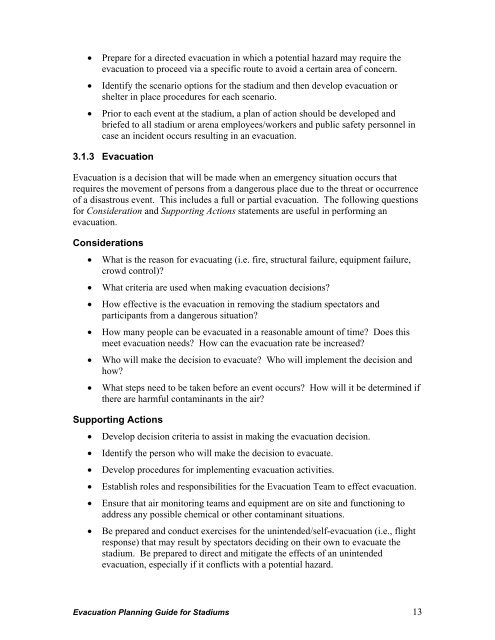Evacuation Planning Guide for Stadiums
Evacuation Planning Guide for Stadiums
Evacuation Planning Guide for Stadiums
You also want an ePaper? Increase the reach of your titles
YUMPU automatically turns print PDFs into web optimized ePapers that Google loves.
• Prepare <strong>for</strong> a directed evacuation in which a potential hazard may require the<br />
evacuation to proceed via a specific route to avoid a certain area of concern.<br />
• Identify the scenario options <strong>for</strong> the stadium and then develop evacuation or<br />
shelter in place procedures <strong>for</strong> each scenario.<br />
• Prior to each event at the stadium, a plan of action should be developed and<br />
briefed to all stadium or arena employees/workers and public safety personnel in<br />
case an incident occurs resulting in an evacuation.<br />
3.1.3 <strong>Evacuation</strong><br />
<strong>Evacuation</strong> is a decision that will be made when an emergency situation occurs that<br />
requires the movement of persons from a dangerous place due to the threat or occurrence<br />
of a disastrous event. This includes a full or partial evacuation. The following questions<br />
<strong>for</strong> Consideration and Supporting Actions statements are useful in per<strong>for</strong>ming an<br />
evacuation.<br />
Considerations<br />
• What is the reason <strong>for</strong> evacuating (i.e. fire, structural failure, equipment failure,<br />
crowd control)?<br />
• What criteria are used when making evacuation decisions?<br />
• How effective is the evacuation in removing the stadium spectators and<br />
participants from a dangerous situation?<br />
• How many people can be evacuated in a reasonable amount of time? Does this<br />
meet evacuation needs? How can the evacuation rate be increased?<br />
• Who will make the decision to evacuate? Who will implement the decision and<br />
how?<br />
• What steps need to be taken be<strong>for</strong>e an event occurs? How will it be determined if<br />
there are harmful contaminants in the air?<br />
Supporting Actions<br />
• Develop decision criteria to assist in making the evacuation decision.<br />
• Identify the person who will make the decision to evacuate.<br />
• Develop procedures <strong>for</strong> implementing evacuation activities.<br />
• Establish roles and responsibilities <strong>for</strong> the <strong>Evacuation</strong> Team to effect evacuation.<br />
• Ensure that air monitoring teams and equipment are on site and functioning to<br />
address any possible chemical or other contaminant situations.<br />
• Be prepared and conduct exercises <strong>for</strong> the unintended/self-evacuation (i.e., flight<br />
response) that may result by spectators deciding on their own to evacuate the<br />
stadium. Be prepared to direct and mitigate the effects of an unintended<br />
evacuation, especially if it conflicts with a potential hazard.<br />
<strong>Evacuation</strong> <strong>Planning</strong> <strong>Guide</strong> <strong>for</strong> <strong>Stadiums</strong> 13


